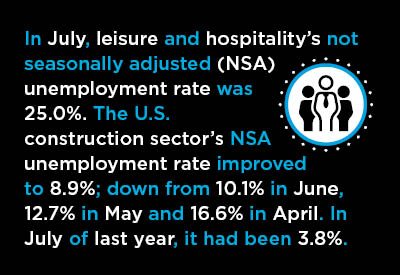In July, according to the Employment Situation report published by the Bureau of Labor Statistics (BLS), the total number of jobs in the U.S. climbed by 1.8 million (after gains of 4.8 million in June and 2.7 million in May) and the seasonally adjusted (SA) unemployment rate eased to 10.2% (after readings of 11.1% in June, 13.0% in May and 14.4% in April).

The nation’s labor market was shredded by coronavirus-related shutdowns in early spring. It is now rebounding, but with less vigor than hoped for. Acting as a drag on jobs prospects have been de-railings of some state re-openings due to surges in new COVID-19 cases. As set out in Graph 1 at the end of this article, weekly initial jobless claims continue to exceed a million.
The big question is: “Where does the U.S. now stand with respect to employment recovery since February-to-April’s precipitous drop?”
Many of the most relevant numbers on the U.S. jobs recovery appear in Table 1.
Claw-Back Ratio for Total Employment 37.3%
The decline in total employment from February to April was 20.5 million jobs. The recovery in total employment since April has been 7.64 million jobs. The claw-back ratio is now 37.3%.
The decline in manufacturing employment from February to April was 1.33 million jobs. The recovery in manufacturing employment since April has been 590,000 jobs. The claw-back ratio in the sector is presently 44.4%.
The decline in construction employment from February to April was 975,000 jobs. The recovery in total employment since April has been 531,000 jobs. The claw-back ratio in the sector is currently 54.5%.
The decline in retail employment from February to April was 2.107 million jobs. The recovery in retail employment since April has been 1.194 million jobs. The claw-back ratio equals 56.7%.
The decline in ‘education and health’ employment from February to April was 2.544 million jobs. The recovery in employment in ‘education and health’ since April has been 933,000 jobs. The claw back ratio is 36.7%.
The decline in ‘leisure and hospitality’ employment from February to April was 7.653 million jobs. The recovery in employment in the sector since April has been 3.313 million jobs. The claw back ratio has reached 43.3%.
Table 1
.png)
Leisure & Hospitality Employment Down by One-Quarter
Whereas total employment in April relative to February (i.e., the last ‘normal’ month before COVID-19) was -13.5%, it is now -8.4%. The shortfall in total employment, relative to February, presently sits at 12.86 million jobs.
Whereas manufacturing employment in April relative to February was -10.4%, it is now -5.8%. The shortfall in manufacturing employment relative to February is 740,000 jobs.
Whereas construction employment in April relative to February was -12.8%, it is now -5.8%. The shortfall in construction employment relative to February is 440,000 jobs.
Whereas ‘leisure and hospitality’ employment in April relative to February was -46.8%, it is now -25.7%. The shortfall in ‘leisure and hospitality’ employment relative to February is 4.3 million jobs.
Construction Workers’ Pay Hikes Languish
In July, leisure and hospitality’s not seasonally adjusted (NSA) unemployment rate was 25.0% (i.e., one-quarter of all workers who claim the sector is usually the source of their livelihoods). Nevertheless, 25.0% is vastly better than the figure of 39.3% tallied in April.
In July, the U.S. construction sector’s NSA unemployment rate improved to 8.9%; down from 10.1% in June, 12.7% in May and 16.6% in April. In July of last year, it had been 3.8%.
Compensation increases for construction workers in July continued to trail all-jobs advances. Economy-wide pay increases in July were +4.8% hourly and +5.4% weekly. Construction workers, as a subset, received pay hikes of +3.2% hourly and +2.7% weekly.
Finally, ‘government’ recorded a strong uptick in employment in July, +300,000 jobs. The federal and state increases were relatively restrained, +27,000 and +33,000, but local government went on a hiring binge, +240,000, almost all of which was in a category labeled ‘local government education’, +215,000.
Graph 1
.png)
Alex Carrick is Chief Economist for ConstructConnect. He has delivered presentations throughout North America on the U.S., Canadian and world construction outlooks. Mr. Carrick has been with the company since 1985. Links to his numerous articles are featured on Twitter @ConstructConnx, which has 50,000 followers.











Recent Comments
comments for this post are closed